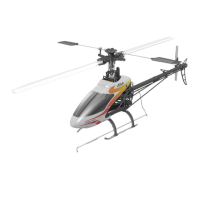
Do you have a question about the Mikado LOGO 400 and is the answer not in the manual?
Guidelines for safe operation of the helicopter in spacious areas, away from people and hazards.
Essential checks and precautions before adjusting and operating the helicopter.
Instructions for attaching the motorplate to the main frame assembly.
Assembly steps for the main frame structure, connecting side frames.
Installation guide for the bearing case within the main frame assembly.
Details on securing the motor to the motor plate and setting the pinion.
Mounting the hub component to the main gear assembly.
Procedure for setting the correct gear backlash for smooth operation and longevity.
Detailed steps for assembling the tail rotor shaft with bearings and pins.
Mounting the vertical fin to the tail boom assembly.
Assembly of the pitch slider mechanism for the tail rotor.
Installing the tail rotor lever onto the tail boom assembly.
Attaching the tail rotor hub components.
Instructions for attaching the tail boom holder and tensioning the drive belt.
Mounting and tensioning the tail drive pulley and belt.
Assembling the tail control rods with ball links.
Mounting the tail assembly into the main frame and adjusting gear backlash.
Attaching the tail rotor blades to the tail rotor holders.
Connecting the tail boom brace with control rods.
Mounting the swashplate and understanding its servo operation.
Preparing and connecting the various linkages for servo control.
Selecting and attaching servo arms, considering pitch range and throw.
Centering the servos and attaching their arms perpendicular to the servo shaft.
Positioning and marking the elevator servo for mounting.
Connecting the elevator linkage to the swashplate.
Securing the helicopter canopy using the designated fixing bolts.
Installation of the left aileron servo.
Installation of the right aileron servo.
Connecting the aileron linkages to the swashplate and servos.
Step-by-step instructions for assembling the wash-out unit.
Mounting the wash-out hub, ensuring smooth vertical movement.
Attaching the blade grips to the main rotor head.
Assembling and installing the mixing arms onto the main rotor head.
Installing the yoke component with bearings and O-rings.
Assembly of the seesaw mechanism for the main rotor head.
Mounting the flybar control bridge.
Attaching the ball bolts to the main rotor head linkages.
Installing the flybar into the rotor head assembly.
Attaching the flybar paddles to the flybar.
Completing the main rotor head assembly with final screws and bolts.
Connecting the rotor head linkages to the swashplate and mixing arms.
Instructions for assembling the battery support structure.
Explanation of 120° CCPM for swashplate control.
Understanding and setting the collective pitch function for lift control.
Setting the aileron (roll) function for longitudinal axis control.
Setting the elevator (tilt) function for forward/backward movement.
General guidelines for programming 120° CCPM on the transmitter.
Importance of servo centering and using sub-trim function.
Adjusting servo travel (ATV) to ensure swashplate levelness and prevent drift.
Choosing and setting pitch values for different flying styles.
Detailed explanation of standard and 3D pitch values and their effect on flight.
Managing travel ranges to avoid swashplate mechanical limits.
Adjusting tail rotor servo arm position and travel for optimal control.
Compensating motor torque using tail rotor pitch or gyro.
Using Heading-Hold gyro mode and its implications for revo-mix.
Methods for maintaining constant rotor head speed via speed controller or governor.
Verifying the correct rotation direction of the main and tail rotors.
Adjusting rotor blade tracking to prevent vibrations and ensure stability.
How to operate the pitch/throttle control stick for lift and speed.
Operating the rudder control for yaw and directional changes.
Using the elevator control stick for tilting the helicopter forward/backward.
Using the aileron control stick for rolling the helicopter left/right.
Detailed breakdown of chassis parts and their assembly points.
Exploded view of the rotor head parts for identification and assembly reference.
Exploded view of tail boom and tail rotor parts.